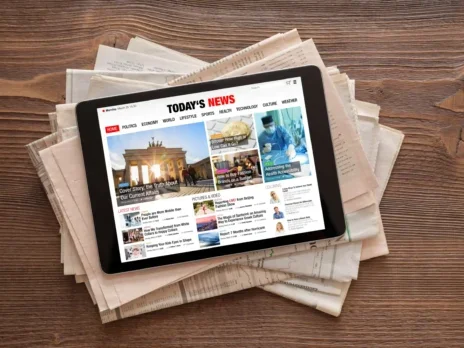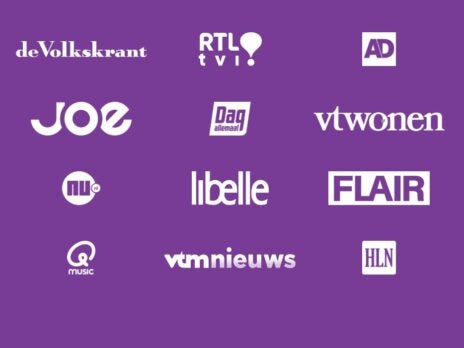
Could old-fashioned SMS texting be a more reliable alternative to fickle social media algorithms for publishers?
That’s the theory of Subtext, which was founded in 2019 within US publisher Advance Local’s tech incubator Alpha Group. This year it will send an estimated five billion text messages.
What is Subtext?
Subtext operates in 200 countries and works with a variety of media companies, artists, political candidates and sports brands.
US publishers using Subtext include: the New York Post, Forbes, Washington Post, Axios, Conde Nast, Gannett, The New Yorker, Page Six, CNET, Punchbowl News, The Hill, CBC, Hearst Newspapers, Buzzfeed, Pitchfork, Vox, PBS, McClatchy, Morning Brew and The Atlanta Journal-Constitution.
They use the platform to drive traffic, engage subscribers, reduce churn and even drive affiliate revenue.
In the UK the platform is less well-known, although Subtext chief executive and co-founder Mike Donoghue told Press Gazette: “You’ll see a fair amount of international expansion for us in the media space in the not too distant future.”
“When we conceived of the idea of Subtext, we took a look at – for media companies and artists and creators – the amount of time and money and love and effort and resources that went into building up these big audiences on social channels only for a lot of those same companies to come to the realisation that they were renting the relationship with their audience, as opposed to owning a really meaningful direct line of communication,” Donoghue said.
[Previous Press Gazette platform profiles have included: Bluesky, Whatsapp Channels, Snapchat and Factiva.]
Subtext versus email newsletters
Alpha Group initially looked at email but decided it was “already really crowded”, with Donoghue pointing to the likes of Beehive, Ghost, Substack, Lead and Tiny Letter (which closed down earlier this year).
In addition, he said, email “doesn’t feel all that personal” compared to texting and its efficacy recently “has been waning”.
“Click through rates are down, open rates are down. The ability to monetise them subsequently is down. So we have a lot of clients that will use text as an alternative to email newsletters, with the added benefit – and I think this is cool – of leveraging the bilateral nature of the communication, meaning you can send a message to all of your subscribers and ask a question.
“So like who is your favourite political candidate, or who’s going to win the football game this weekend, or whatever it’s going to be, your audience can respond to you one on one, and you can pull them, you can create participatory experiences for them.”
Donoghue also said email could be affected by AI assistants providing summarised versions of people’s inboxes. He described an “AI-driven distillation and race to the bottom in terms of quality of content”.
Conversely, Donoghue said, texting still has an average open rate of 98% and Subtext has a 32% clickthrough rate which he called “markedly better than email”.
Subtext versus Whatsapp
Meta-owned rival Whatsapp is still a smaller player in the US messaging market, where it hit 100 million monthly active users (almost a third of the population) in July.
But in the UK Whatsapp is the most popular messaging service according to Ofcom, which said in a report last year it had been used by 76% of adults in the previous three months and that it was the main online communication service of 65%.
As a result some publishers have been driving engagement using its Channels and Communities functions which, respectively, allow publications to broadcast articles to any user who subscribes to their feed or to set up groups of up to 2,000 members to share stories and information.
Mirror and Manchester Evening News publisher Reach last year claimed an open rate for messages shared through Communities of around 90%.
Donoghue argued that Subtext has “a couple of meaningful differentiators” from Whatsapp.
Whatsapp’s Communities tab, he said, is “relegated to the back end of the app itself because it creates a lot of static and I don’t even really think that Meta knows how they want to use it at this point”.
In addition, he said, Subtext users own all of their data and can take it to another platform or plug it into another use case whereas Meta owns user data gathered on Whatsapp.
Donoghue said: “Meta, at any time, could change the rules and decide you spent all this time and money to build up this audience in Whatsapp and now you can only talk to 10% of them or you can only talk to 5% of them. So it’s a reskinning of any other social algorithm.
“The other thing I would say, and this is based on real world experience, but Whatsapp if you do it at scale can be a very expensive proposition. SMS isn’t cheap, but Whatsapp messaging at that sort of scale tends to be pretty pricey.”
How Subtext works
Sending SMS messages at scale is “deceptively complicated”, according to Donoghue. Delivering thousands of messages at once requires a relationship with the phone networks and the phone number sending them needs to be registered.
Subtext has a dashboard through which clients can compose messages and add emojis, links, audio and GIFs and choose who to send them to, meaning potentially just a particular zip code or country. It also means people can reply to the messages, with their responses appearing on the dashboard, without creating an unwieldy group chat situation.
“Let’s say the alternative is building up a really big list of phone numbers and then from your phone trying to send a text message to all those people,” Donoghue said. “It turns into a group chat where you have 10,000 people talking all at once and it’s hard to follow the thread.”

Subtext offers two revenue models: publishers are more likely to pay a licensing fee to use the platform with additional costs relating to the total number of messages sent in a month. This model is scalable, Donoghue said, meaning large publishers pay more than tiny outlets with a low number of subscribers.
The second model, which is more popular with creators or other sole practitioners like individual journalists, is a paid subscription model like newsletter platform Substack. For example the personality might charge $10 a month and share a cut of that revenue with Subtext. This is a similar model to Substack, which UK local long-read publisher Mill Media has just decided to leave because the platform’s 10% revenue cut would mean the publisher losing more than £100,000 next year.
“It’s proven to be really popular with creators because it creates a financial annuity and an audience that they can own versus having to monetise social platforms through, like, brand sponsorships, which could be really fleeting, and it has a drag on your community,” Donoghue said.
Subtext has done a deal with News Revenue Hub, a US non-profit that works with newsrooms to help them develop sustainable revenue models without paywalls in an attempt to keep quality information free and accessible to all. The deal gives a 50% discount on use of Subtext to more than 100 newsrooms that are in a paid relationship with News Revenue Hub, whether through the use of their fundraising software or their consulting services.
News Revenue Hub chief of staff Sarah Bishop Woods, who previously used Subtext when she worked at Vox Media, told Press Gazette why texting is attractive to their publisher partners: “News means something different today. It’s much more engaged in a person’s life. It’s much more a service than just a broadcast…
“We know that traffic declines to websites have been ongoing and there’s some expectation that changes with artificial intelligence and SEO declines that it might be more difficult for people to discover news in the same habit that they’re used to discovering news over the last decade. But habits change, and we need to change with the times, instead of against them. And we’ve always encouraged our newsrooms to develop a deep and loyal relationship with the people they serve. A lot of that product can be, you know, newsletters or events, really smart and strategic social media distribution, but increasingly, it also means literally going reaching someone where they are.”
But she also warned: “When we’re thinking of audience diversification, SMS texting with tools like Subtext is really important but it does not diminish the importance of doing on the ground, community engagement as well.
“It’s something that creates a whole picture, but it’s certainly not something that you can remove something else and expect to have success. So we’ve really been encouraging our newsrooms to develop a whole strategy instead of piecemealing ideas.”
How news publishers are using Subtext
Caitlin Petrakovitz, senior digital editorial manager and director of messaging experiences at Gannett, told Press Gazette the USA Today Network is using Subtext in different ways “from SMS sports focused groups to local weather alert groups and beyond”.
This year USA Today launched Your Vote, a free text group via Subtext that promises to “help you cut through the noise of TV ads and spam calls and talk about how this year’s elections will impact you”.
Petrakovitz said: “With nearly 5,000 current subscribers, we aim to inform people in a more personal and authentic way, answering questions in real time directly from our reporters and receiving feedback from readers that helps improve our coverage.”
Here are some specific use case examples:
Driving traffic and getting stories out quickly
Donoghue noted that many people do not sit all day in front of a computer and might miss breaking news updates.
“If you wanted to break that news on X [formerly Twitter] or something, you can share that, but it means, one, that user needs to be on X, two, the algorithm needs to decide that it gets delivered immediately, and, three, they need to be part of that audience cohort that’s actually going to see the message,” he said.
“Whereas with text messaging, for example, it’s going to get delivered to 100% of the audience within less than a minute.”
Public service information
Texting is a resilient tool that can be used to get information out even during internet and power outages, according to Donoghue.
More than 8,000 people signed up to receive updates on curfews, food and school openings from McClatchy titles Miami Herald and Bradenton Herald or Gannett’s Sarasota Herald-Tribune when millions were left without power due to Hurricane Ian in Florida in 2022.
Donoghue said: “SMS is a really vital communication tool to those users and because it operates without an internet connection, it can be a really important way to keep people safe and keep them informed. Whereas email newsletters would not be able to do that. The general website, social, would not be able to do that.”
Donoghue also raised the example of LA Taco journalist Lexis-Olivier Ray who primarily covers the unhoused population in Los Angeles and has a text group of about 100 people sharing information about services they might need.
“He doesn’t have 100,000 subscribers, and it’s not a commerce use case, not making a ton of money off of it. But what he does is communicate really crucial updates…” Donoghue said.
Subscription strategies
Of the potential for subscription-based businesses, Donoghue said: “In this scenario, maybe you have a paid digital offering and the ability to text with individual journalists or to receive texts on a subject that is really of interest to you is a value add, and the goal there for media companies, for publishers, is to differentiate their paid subscription offering.
He added: “It’s also meant to engage what we would call normally zombie subscribers, so people that sign up for a subscription, they don’t come to the site every day and read stories, so they’re not getting the requisite value, and it’s really only a matter of time until they remember that they’re paying for it, and then they cancel. So it’s a churn reduction effort. It’s a subscriber engagement effort.”
The Washington Post told Press Gazette its longest project on Subtext has been Texts with Tumulty (pictured, top), through which opinion columnist Karen Tumulty shares updates with her most engaged readers (dubbed Tumultexters) while she’s on the 2024 US presidential election campaign trial, and occasionally answers their questions.
A Post spokesperson said: “We’ve seen great success by building a solid core community in the thousands of ‘Tumultexters’, with a high engagement rate of people opening and engaging in these snackable updates. Highlights from Karen include her insights on Super Tuesday and on-the-ground at the conventions, with updates continuing through the election.”
According to Subtext, USA Today newsletter The Short List sends a headline and link to the full read each day and found that text message subscribers spend longer on the articles.
It can also be used to help with acquisition: Donoghue said for example media companies could make it free to sign up for updates about big tentpole events like the Olympics or the US election in the hope of converting users into paying subscribers.
Affiliate revenue
Donoghue described e-commerce as an “emerging popular use case”.
The likes of Wirecutter at The New York Times, Forbes and CNET which have large affiliate businesses put out messages like daily product round-ups and flash sales, he said.
A Buzzfeed case study on the Subtext website states: “Buzzfeed Shopping used Subtext to great effect during the holiday shopping rush, learning from subscribers about what products were on their holiday wish list. Subtext helped them gain valuable audience feedback and increase final conversions and overall customer satisfaction.”
Email pged@pressgazette.co.uk to point out mistakes, provide story tips or send in a letter for publication on our "Letters Page" blog







